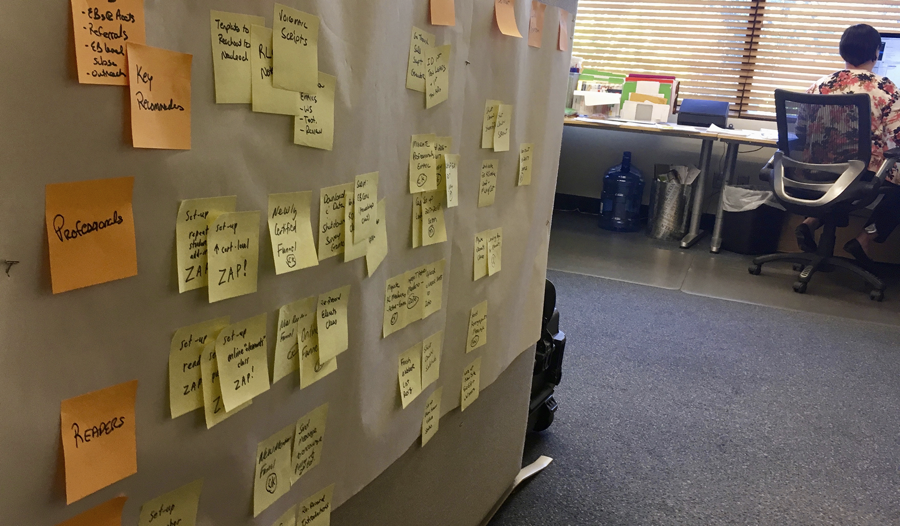Recently, my thinking about Key Decisions has changed. I used to think that teams needed to address all their high impact/high unknown Key Decisions and that teams could be trusted to come up with the right ones within a few cycles of re-planning, even if they struggled during the integration event.
I now think that fewer, bigger, more focused Key Decisions lead to better results than a long list of smaller Key Decisions.
Fewer Key Decisions Lead to More Focus
These bigger Key Decisions raise the bar on the impact that a decision needs to have before it rises to the level of a Key Decision. This lowers program management overhead during the learning phases, and makes it easier to balance workloads among team members.
Fewer Key Decisions mean less work for the team and more focused Integration Events for the leaders. Team members are more likely to write good, meaty Knowledge Gap questions and are less likely to clog the list with Knowledge Gaps that are really just the work of engineering the product.
But if a team is not tracking ALL of their high-impact / high-unknown decisions, how do they know where to find the real Key Decisions?
Find Your “NUDs” to Find Your Key Decisions
Today, I coach teams to search for the NUDs about the program — the things that are New, Unique or Difficult — before brainstorming Key Decisions. These are the major areas where a team’s instincts could be miscalibrated and guesses are more likely to be wrong.
- What’s New: What has the team never done before? Note: something is new to the team even if someone else in the world has done it, and it looks easy to replicate.
- What’s Unique: What is different about this product? For example, are you selling an existing product into a new application area for the first time? Are you combining two known technologies that haven’t been put together before?
- What’s Difficult: Where do your teams always seem to struggle? What are the sticky integration points? What already looks ugly?
These are the areas of the program where your most important Key Decisions are likely to be found.
Other Key Decisions should be NUD-sized
You may still have other areas with high impact / high unknown decisions that don’t come up when the team looks at NUDs. I would question whether or not these other Key Decisions have the same importance.
If they don’t, the team may be better off moving these down to the “Best Guess” category so that they can focus on the bigger issues. If they do, then you’ve just found something “NUD-sized” that should be tracked as a Key Decision.
NUDs Predict Launch Date
When I first started working with teams in this way, I wondered about the Key Decision Flow and the metric of “Key Decisions Closed On Time.” Would that metric still be as predictive of whether or not a team was doing well, or starting to get into trouble?
So far, the teams using this have not lost the ability to expose early warning signals that this metric provides. And when I reflect on teams where this metric has been an early indicator of trouble, the trouble light went on first in an area that could have been flagged as a NUD.
So I now feel confident recommending this as a way to develop Learning Cycle Plans that make the most of the time a team has to learn, without cluttering up the program with too many Key Decisions or Knowledge Gaps.
What If You Already Have Too Many?
If your team is struggling with too many Key Decisions and/or Knowledge Gaps, it’s worth taking some time at your team’s next Learning Cycles Event to do a bit of a reset:
- Ask the team to develop a list of NUDs independent of the current Learning Cycles Plan. For this purpose, it’s enough to have a list of short phrases like packaging design, new resin type, new distributor.
- Then validate that each of these NUDs is represented somewhere with at least one Key Decision per NUD. You can place a check mark on Key Decisions that are related to your NUDs list.
- Add any that are missing into the Key Decision Flow.
- Look at the remaining Key Decisions that weren’t checked: are they NUD-sized? If not, consider removing them from your Key Decision Flow, and removing their Knowledge Gaps from the Learning Cycles Plan.
- Break the new Key Decisions down into Knowledge Gaps, and then integrate them into the Learning Cycles Plan where it makes sense.
If your plan is cluttered with a lot of Key Decisions, you could end up taking off five Key Decisions for every one that you keep. That will help your team focus, help your decision makers make cleaner decisions at Integration Events, and help you spend less time on project management to spend more time learning yourself.



